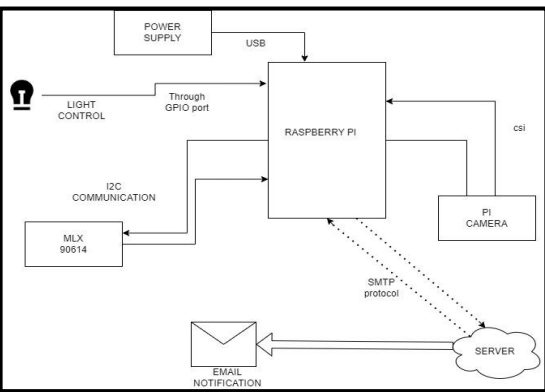
Submission to VIJ 2024-01-18
Keywords
- IoT, Thermal Camera, Home automation, Temperature Measurement
Copyright (c) 2024 Kanishka Gupta, Tanay Gattani, Prakash Parmar, Amit Aylani

This work is licensed under a Creative Commons Attribution 4.0 International License.
Abstract
The Human Detection project utilizing thermal sensors aims to detect individuals or groups in the surrounding environment and respond accordingly. For instance, it can adjust lighting in a room or on a street to accommodate the presence of an individual instead of illuminating everything. Thermal sensors can also detect the presence of people and cars, making street lighting smart and adapting to the lighting situation accordingly. This technology can save up to 70% of energy costs while maintaining safe streets in high-crime areas and creating room for photovoltaic cells. Accurate occupancy tracking and temperature control are crucial in any organization or society, particularly in crowded places like hospitals or malls. To address this issue, we are introducing a data-driven electronic and sensor-based system that can detect the overall environment's temperature. This system is not a simple machine that gives a single output related to human temperature, but it provides real-time data to detect other parameters for multiple applications.
References
- Jain, N., Gupta, A., & Gupta, R. (2015). Heat vision based home automation system using Raspberry Pi. In 2015 International Conference on Futuristic Trends in Computational Analysis and Knowledge Management (pp. 346-349). IEEE.
- Raman, S., Sahoo, S. K., & Nayak, S. K. (2016). Heat vision based home automation system. In 2016 IEEE International Conference on Advances in Electronics, Communication and Computer Technologies (ICAECCT) (pp. 1-6). IEEE.
- Gopalan, S., Ramakrishnan, M., & Thiyagarajan, P. (2018). Heat vision based home automation using Arduino. In 2018 2nd International Conference on Inventive Communication and Computational Technologies (ICICCT) (pp. 352-356). IEEE.
- Gupta, A., Singhal, A., & Gupta, A. (2017). Heat vision-based home automation system using Raspberry Pi. In 2017 International Conference on Intelligent Computing, Instrumentation and Control Technologies (ICICICT) (pp. 703-706). IEEE.
- Kumar, R., Sharma, S. K., & Sharma, P. (2019). Heat vision-based smart home automation system using machine learning algorithm. In 2019 5th International Conference on Advanced Computing & Communication Systems (ICACCS) (pp. 1-5). IEEE.
- Singh, N., Kumari, R., & Kumar, R. (2020). A heat vision based smart home automation system using neural network. In 2020 11th International Conference on Computing, Communication and Networking Technologies (ICCCNT) (pp. 1-6). IEEE.
- Singh, A., Roy, A., & Jana, S. (2021). Heat vision based smart home automation using machine learning algorithm. In 2021 4th International Conference on Computing Methodologies and Communication (ICCMC) (pp. 175-178). IEEE.
- Aylani, A., Pawar, A., Naik, A., & Mane, S. (2021). Home Automation System: Smart Devices in International Research Journal of Engineering and Technology